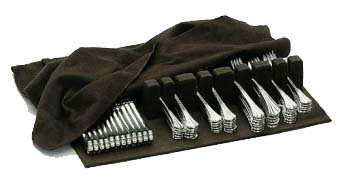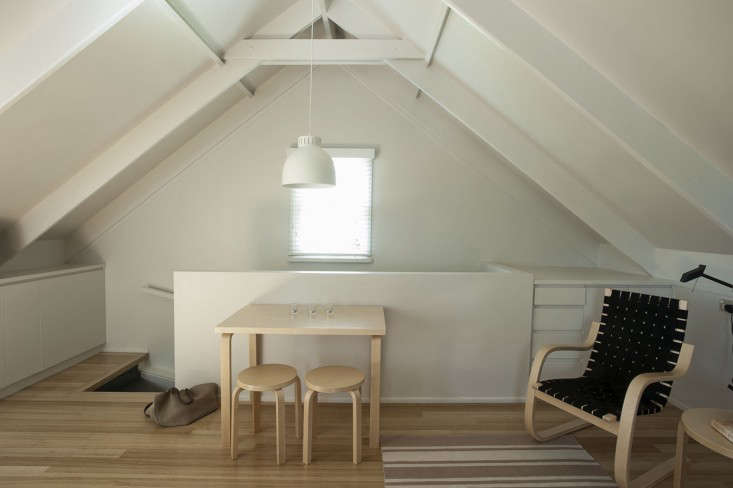There was a time when glue gun novices like me did not believe ourselves capable of whipping up a custom silverware drawer insert on a lark. We lived in a world where other people made things for us. But now, with a few clicks, you can buy pretty much any sort of craft supply, including tarnish-resistant fabric by the yard (in six colors). The other day my husband came home to find me looking crazed and desperate, with little tufts of silvery cloth stuck to my arms.
"My God, you've tarred and feathered yourself," he said.
"Just one more hour, that's all I need," I muttered, as I accidentally hot glued my thumb to a piece of cardboard.
See Video: Clone Herbs in Your Kitchen.
He looked around the kitchen—strewn with bits of foam board, dulled Exacto knife blades, Styrofoam blocks, sticky paint brushes, and scraps of fabric—and said, in the fake-friendly persuasive tone of a SWAT team negotiator, "Hand me the glue gun."

Above: My thrift-shop flatware drawer, before my intervention. Photograph by Mimi Giboin.
How did I find myself in such a mess? The short answer is: I had a jumble of thrift-shop silverplate flatware that I'd tossed into a drawer in my former dining room (now The Library). I needed to organize it, but none of the typical easy options was a solution.
For example, I had been unable to fix the problem with a Reed & Barton Silvercloth Flatware Holder ($45 from Amazon) because my knife handles were too wide to fit in its slots (a problem that became apparent only after I'd bought it; the product description did not describe the size of the knife slots).
For a while, I'd flirted with the idea of asking Lloyds of Lancaster County—the same company that made Tiffany & Co.'s jewelry display case inserts—for a custom sized silvercloth-lined drawer insert. But when I phoned for information, I learned that before I could even get a price estimate, I would have to make photocopies of every different kind of flatware piece I owned—dinner fork, salad fork, soup spoon, teaspoon, and knife. Then I would have to measure the thickness of each piece and write that dimension on each photocopy, and then mail everything to Lloyds. This proved too much for me.

Above: My overflow china cabinet drawers awaiting their rehab. Photograph by Mimi Giboin.
I suppose I could have left the messy jumble alone, and I considered that. But then I had a conversation with a silverware expert—designer Sue Fisher King, who owns an eponymously named housewares store in San Francisco—and she assured me that to do nothing would lead to disaster.
"You don't want to throw silverware into a drawer where it is all mushed together and it will get scratched," she said. Sterling silver is about .925 percent pure silver, she said, and "silver is a very soft metal."
In her own home, Sue Fisher King said, "I have three drawers, with a silverware box in each, with dividers lined with anti-tarnish cloth. This is what you want."
Yes, this was what I wanted. Very badly, all of a sudden, as I sat there picturing Sue's three drawers lined with soft cloth, her forks and spoons nestled protectively in their warm beds. So what if my silverplate was from the thrift shop? It still deserved love, didn't it? I keep my good silver—sterling inherited from my husband's family—ensconced in a luxuriously lined box in a kitchen drawer. It seemed cruel to have a double standard.
"I'll make my own," I told her.
"Good luck," she said.

Above: In my kitchen, where my fancy flatware lives, I have a custom silverware box lined in a cheerful apple green anti-tarnish cloth. Photograph by Mimi Giboin.
Oh, hubris! What makes people like me (impatient, un-craftsy, math-averse amateurs who are unable to imagine the solutions to theoretical problems in three dimensions) think we can succeed at a complicated DIY project? I blame society.
Not so long ago, we relied on other people—experts in their respective fields—to handle everyday tasks. But travel agents and bank tellers have disappeared, and instead we are expected to manage our own lives. At the drugstore I use self-service checkout and have even learned to bag my own Advil. These days nobody drives to the telephone company's office to pay the bill, as my grandfather did every month for 60 years.
We live in a "self-servicing" age. It's a phenomenon that fascinates researchers like Colin Williams, a public policy professor in England who recently surveyed 5,500 people in the UK town of Sheffield to try to get to the bottom of our growing belief that we can—and should—do everything for ourselves by ourselves. What he concluded is that the rest of the world has conspired to make us feel conspicuously self-sufficient (hello, flat pack furniture we're expected to assemble with an Allen wrench).
"Consumers now dial a telephone number themselves instead of using a telephone operator, press a button in an elevator rather than using an elevator operator, push their shopping cart around a food store rather than request a salesperson to collect each item for them," Prof. Williams wrote.
The inevitable result has been to transform mild mannered people like me into rabid DIY-ers.
And so I devised a plan.

Above: My fancy flatware (inherited from my husband's family) is coddled already, in a kitchen drawer. Photograph by Mimi Giboin.
I bought materials—including Treated Silver Cloth, (at $22.95 per yard from Nancy Silver), a glue gun, white glue (as a backup), glue brushes, an Exacto knife, 3/8-inch-thick pieces of foam to make dividers, a sharp pair of scissors to cut fabric, and Styrofoam—and never mind that the cost was more than $100.
My kitchen looked like the operating room in that Grey's Anatomy episode where the patient who is turning into a tree has to have his branches removed surgically. (For a full materials list and step-by-step instructions, see DIY: (Not So) Easy Silverware Drawer Insert.)
And then, at 8:30 am on Friday morning, I got started.

Above: My overflow china cabinet, where my thrift-shop silver lives. Photograph by Mimi Giboin.
The project went the way of most DIYs, with my mood following the same emotional trajectory as the five stages of grief identified by Elisabeth Kübler-Ross.
In denial that doom lay ahead, I sketched a picture of an idealized finished product and then cut foam pieces.
Anger set in three hours later after I realized I'd mis-measured and would have to re-cut all the foam pieces.
Bargaining with God (if there is a God, because what kind of God would sit by in silence instead of holding down that flap of fabric for me so I could glue it on tighter?), I promised to simplify my design if only He would allow me to complete this project before nightfall.
Depression hit around 5:30 pm after I finally assembled the pieces and realized that after nine hours I'd managed to make one drawer insert capable of holding nothing more than a few knives (see below) and a second drawer insert without dividers.

Above: Post-DIY; my thrift shop silver drawers. Photograph by Michelle Slatalla.
And then, finally, acceptance, sweet acceptance of my drawer inserts' limitations—as my husband picked bits of cloth from my hair and handed me a curative concoction he described as "a whiskey poultice."
I vowed, as I held an ice cube against my glue-gunned thumb, never to do another DIY project again.
And then, on Saturday morning I woke and took a closer look. As after childbirth, the hellish memory was fading in the face of my love for my creation. Suddenly I adore my silverware inserts! How cleverly they fit the drawers. What a pretty, mossy-green color.
There must be some easy DIY solution to add dividers to that drawer. I'll report back after I get home from the craft store.
Not scared off yet? See DIY: (Not So) Easy Silverware Drawer Insert.
Subscribe to get more of Michelle's weekly Domestic Dispatches adventures.





Have a Question or Comment About This Post?
Join the conversation (0)